This dynamic radar cruise control system employs advanced radar sensors to detect vehicles ahead, accurately measure the gap between them, and automatically adjust acceleration and braking to maintain a safe following distance. You can customize the desired gap using the dedicated vehicle-to-vehicle distance switch. For optimum performance and safety, use the dynamic radar cruise control exclusively on highways and expressways.
WARNING
For safe use
Conditions under which the system may not operate correctly
Precautions for the driving assist systems
Keep in mind that the support provided by dynamic radar cruise control is limited. Adhering to the precautions below is essential because inappropriate reliance on the system could result in severe injury or death.
Situations in which the dynamic radar cruise control should not be used
Avoid using the dynamic radar cruise control in situations where the system cannot reliably provide assistance; misuse under such conditions may result in serious accidents.
In addition to enhancing driver comfort and reducing fatigue, dynamic radar cruise control plays a vital role in advanced driver assistance by automating routine driving tasks under appropriate conditions. This innovative technology not only helps maintain safe distances in dense traffic but also contributes to smoother driving dynamics and improved fuel efficiency. Integrated with adaptive sensor technology, it stands as one of the cutting-edge safety features demonstrated in the Toyota bZ4X.
Basic functions
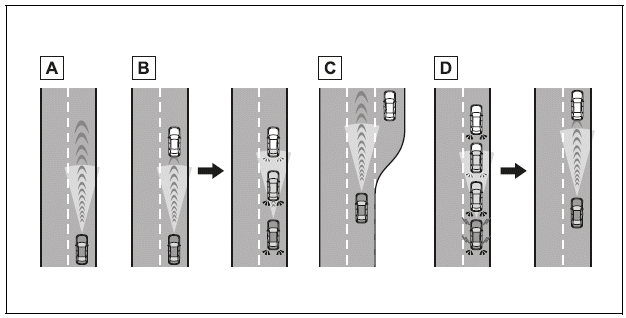
The vehicle maintains the speed set by the driver, ensuring smooth travel on open roads. This constant speed cruising mode stabilizes the vehicle's momentum and optimizes fuel efficiency. If the vehicle exceeds the set speed-typically when descending a hill-the speed display will blink and an audible buzzer will alert the driver, reinforcing safe driving practices.
This system delivers real-time feedback, allowing drivers to adjust their behavior quickly and remain within safe speed limits even when encountering challenging road gradients.
When a slower-moving vehicle is detected ahead, the system initiates automatic deceleration.
The vehicle begins to decelerate smoothly, and if additional speed reduction is required, the brakes are applied-at which point the stop lights are activated. The system continuously adjusts the vehicle-to-vehicle distance based on the driver's preset gap, matching the speed fluctuations of the leading vehicle. If deceleration is insufficient and the gap narrows too quickly, an approach warning sounds, prompting immediate driver attention.
Once there are no slower vehicles ahead, the vehicle accelerates gradually until reaching the preselected speed.
This controlled acceleration minimizes abrupt speed changes, ensuring a comfortable and energy-efficient transition back to constant speed cruising while sustaining long-distance drive efficiency.
In controlled stop operation, the vehicle safely halts when a leading vehicle stops, and it waits for an explicit driver command to resume movement. This functionality is crucial in heavy traffic or congested conditions, ensuring that the system never compromises safety due to delayed driver response.
This integrated suite of cruise control modes-constant speed travel, adaptive deceleration, smooth acceleration, and controlled starting off-enhances driving comfort and promotes road safety by blending automation with driver oversight. By delivering precise real-time adjustments based on traffic conditions and road gradients, this dynamic radar cruise control system stands as a key component of advanced driver assistance technologies. Its robust performance is perfectly demonstrated in the innovative Toyota bZ4X, setting new benchmarks in automotive safety and fuel efficiency.
System components
Meter display

Switches
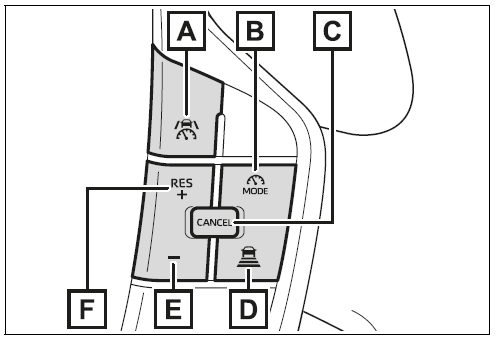
Using the dynamic radar cruise control
Setting the vehicle speed
The dynamic radar cruise control indicator will illuminate.
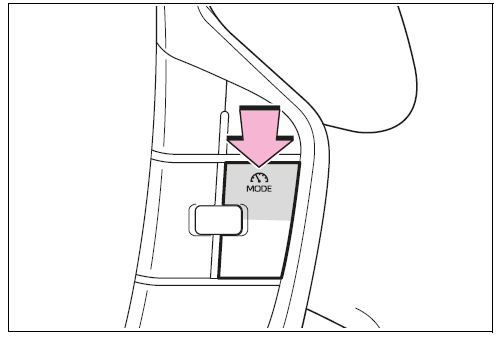
The set vehicle speed will be displayed on the multi-information display.
The vehicle speed at the moment the switch is released will be the set vehicle speed.
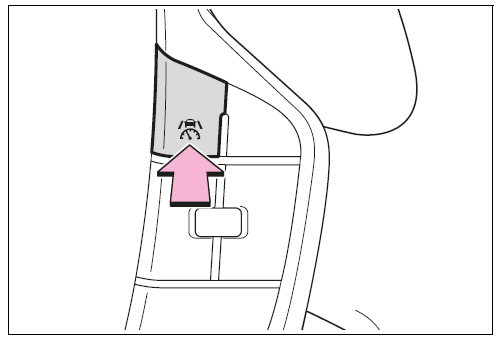
Adjusting the set vehicle speed
To change the set vehicle speed, press the "+" switch or "-" switch until the desired speed is displayed.

Short press adjustment: Press the switch
Long press adjustment: Press and hold the switch until the desired set vehicle speed is reached.
The set vehicle speed will increase or decrease as follows:
Short press adjustment: Increases or decreases by 1 mph (1.6 km/h) each time the switch is pressed Long press adjustment: Increases or decreases in 1 mph (1.6 km/h) increments continuously while the switch is pressed and held
Short press adjustment: By 1 km/h (0.6 mph) or 1 mph (1.6 km/h) each time the switch is pressed
Long press adjustment: Increases or decreases in 5 km/h (3.1 mph) or 5 mph (8 km/h) increments continuously while the switch is pressed and held
Canceling/resuming control
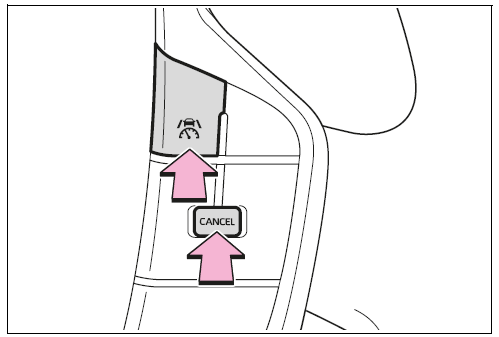
Control will also be canceled if the brake pedal is depressed. (If the vehicle has been stopped by system control, depressing the brake pedal will not cancel control.)
Changing the vehicle-tovehicle distance
Each time the switch is pressed, the vehicle-to-vehicle distance setting will change as follows: If a preceding vehicle is detected, the preceding vehicle mark (A) will be displayed.
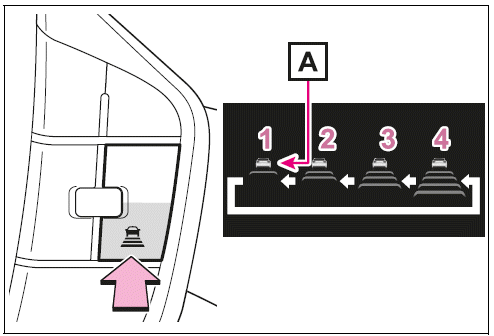
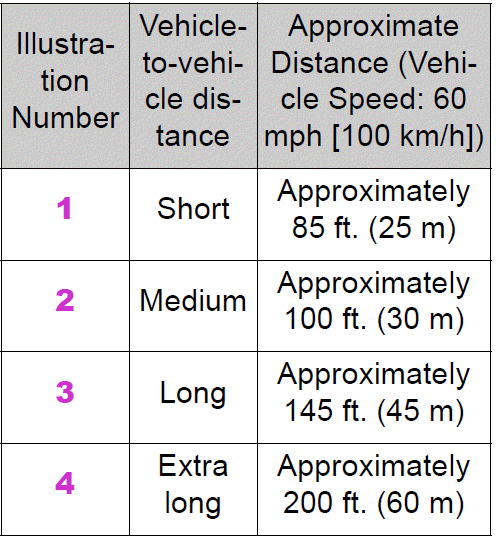
The actual vehicle-to-vehicle distance varies in accordance with the vehicle speed. Also, when the vehicle is stopped by system control, it will be stopped at a certain distance from the preceding vehicle, depending on the situation, regardless of the setting.
Operating conditions
Accelerating after setting the vehicle speed
Similar to normal driving, acceleration is performed by pressing the accelerator pedal. Once acceleration is applied, the vehicle will eventually return to the preselected speed. However, when in vehicle-to-vehicle distance control mode, the vehicle may decelerate slightly below the set speed to safely maintain the desired gap from the preceding vehicle.
When the vehicle is stopped by system control during follow-up cruising
Automatic cancelation of vehicle-to-vehicle distance control mode
The vehicle-to-vehicle distance control mode will be automatically canceled under the following conditions:
The parking brake may also engage automatically under certain conditions.
Dynamic radar cruise control system warning messages and buzzers
For safe operation, the system provides timely warning messages and audible buzzers to alert the driver of critical changes in traffic conditions.
Preceding vehicles that the sensor may not detect correctly
In situations where the system is unable to provide sufficient deceleration or accelerate as needed because of limited sensor detection, the driver must manually operate the brake or accelerator pedals. Due to these sensor limitations, the approach warning may not always function reliably.
Conditions under which the system may not operate correctly
If the sensor fails to correctly detect a vehicle, the system might not function as designed. In such cases, the driver should apply the brake or accelerator pedal as needed.
Approach warning
When the vehicle approaches a preceding vehicle and the system is unable to supply sufficient deceleration-such as when a vehicle abruptly cuts in-a warning display will flash and the buzzer will sound. This approach warning urges the driver to depress the brake pedal in order to maintain the appropriate vehicle-to-vehicle distance.
Warnings may not occur when
In some scenarios, warning signals may not be triggered even if the distance is short:
This intelligent dynamic radar cruise control technology enhances driver convenience and road safety by automatically adjusting vehicle speed, ensuring a safe following distance under varying traffic and road conditions. Its refined adaptive functions not only optimize fuel efficiency and smooth acceleration but also provide crucial real-time warnings to keep drivers alert. The integration of such advanced features contributes significantly to overall driving safety, as demonstrated by the innovative Toyota bZ4X.
Curve speed reduction function
When a curve is detected, the system gradually reduces the vehicle's speed to improve stability and maintain optimal traction during cornering. Once the curve ends, the deceleration control ceases and the vehicle resumes its preset speed, ensuring a smooth transition between different road segments.
Depending on road conditions and system settings, the vehicle may automatically return to the set speed after the curve. However, if vehicle-to-vehicle distance control is active-such as when a preceding vehicle suddenly cuts in-the curve speed reduction function will be canceled to prioritize maintaining a safe following gap.
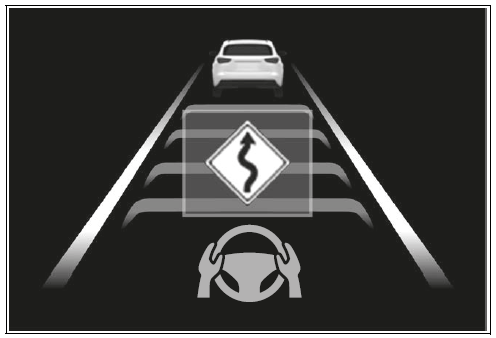
Situations in which the curve speed reduction function may not operate
There are several scenarios where this function may not be activated:
Driver Monitor support function (if equipped)
If a warning from the driver monitor is displayed, the system temporarily restrains vehicle acceleration. This measure helps ensure that the driver remains attentive during critical moments. Once the warning is no longer displayed, normal acceleration control is fully restored.
Support for lane change
At highway speeds of approximately 50 mph (80 km/h) or more, when you initiate a lane change by activating the turn signal, the system assists by accelerating the vehicle up to the preset speed to facilitate overtaking. The determination of which lane is designated as the passing lane is often based on the position of the steering wheel (i.e., left-hand drive or right-hand drive). In markets with opposite driving conventions from those for which the vehicle was initially designed, the system may accelerate even when the turn signal is used away from the designated passing lane. If, after changing lanes, the vehicle finds itself in a slower-moving lane, it will gradually decelerate to help maintain a safe gap with surrounding traffic.
Changing Dynamic radar cruise control settings
The dynamic radar cruise control settings can be customized through the vehicle’s settings menu. Here, drivers can adjust parameters such as the desired vehicle-to-vehicle distance and acceleration sensitivity to align the system's performance with their individual driving habits and prevailing road conditions, thus enhancing overall driving comfort and safety.
By integrating real-time sensor data with adaptive algorithms, these functions work together to create a safer, more responsive driving environment. The curve speed reduction feature, combined with lane change support and customizable dynamic cruise control settings, not only enhances vehicle stability and control but also contributes to improved fuel efficiency and a more relaxed driving experience. The intelligent integration of these advanced safety and driver-assist technologies is perfectly exemplified in the Toyota bZ4X.
Display and system operation state
The operating state of Dynamic radar cruise control is indicated.
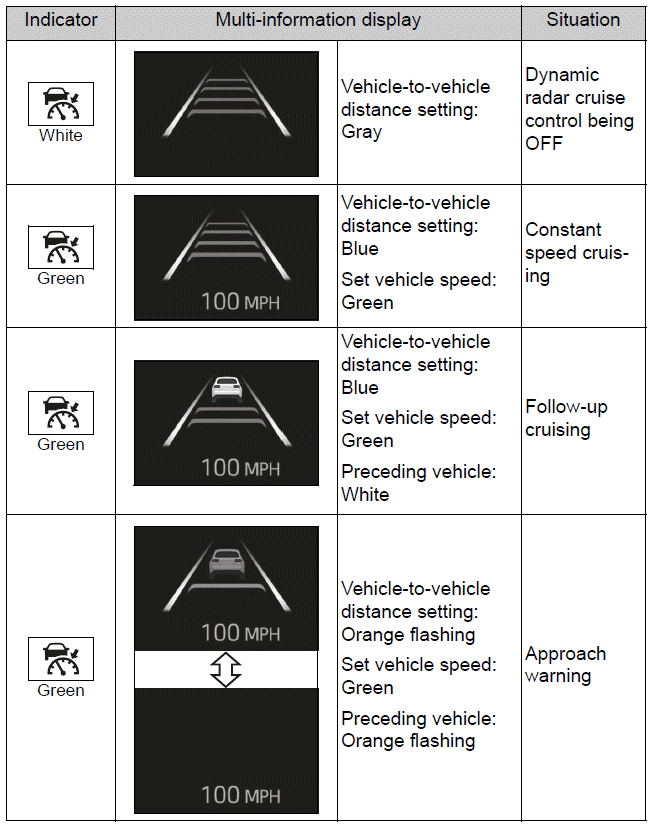
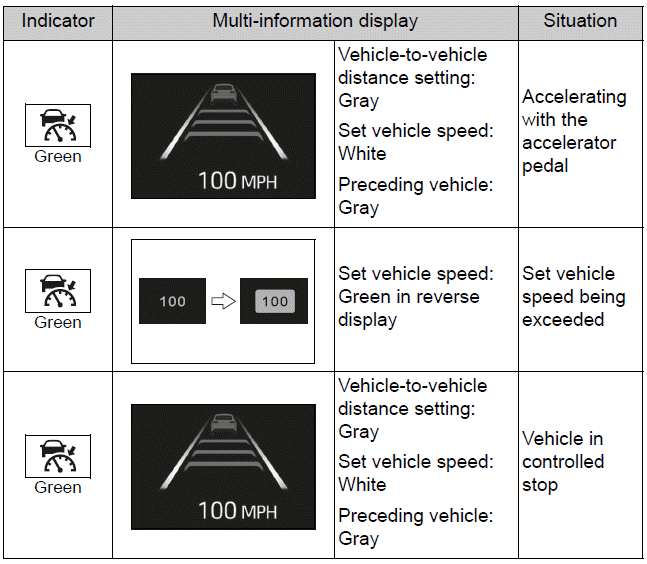
Indicator → Multi-information display → Situation
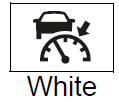 →
→
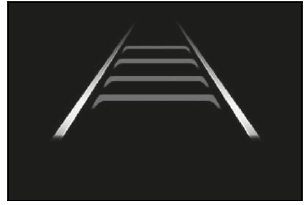 → Vehicle-to-vehicle
distance setting:
Gray → Dynamic
radar cruise
control being
OFF
→ Vehicle-to-vehicle
distance setting:
Gray → Dynamic
radar cruise
control being
OFF
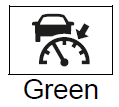 →
→ 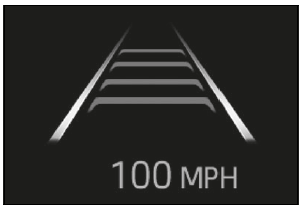 →
Vehicle-to-vehicle
distance setting:
Blue.
→
Vehicle-to-vehicle
distance setting:
Blue.
Set vehicle speed: Green → Constant speed cruising
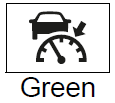 →
→ 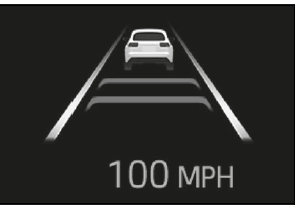 → Vehicle-to-vehicle
distance setting:
Blue.
→ Vehicle-to-vehicle
distance setting:
Blue.
Set vehicle speed: Green.
Preceding vehicle: White → Follow-up cruising
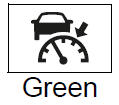 →
→ 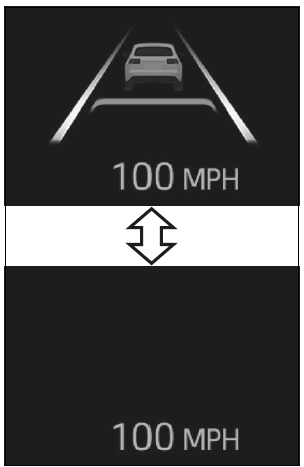 →
Vehicle-to-vehicle
distance setting:
Orange flashing.
→
Vehicle-to-vehicle
distance setting:
Orange flashing.
Set vehicle speed: Green.
Preceding vehicle: Orange flashing → Approach warning
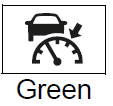 →
→
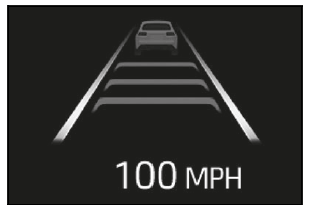 → Vehicle-to-vehicle
distance setting:
Gray.
→ Vehicle-to-vehicle
distance setting:
Gray.
Set vehicle speed: White.
Preceding vehicle: Gray → Accelerating with the accelerator pedal
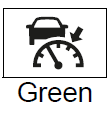 →
→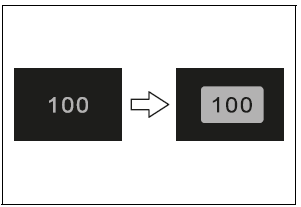 → Set vehicle speed:
Green in reverse
display → Set vehicle
speed being
exceeded
→ Set vehicle speed:
Green in reverse
display → Set vehicle
speed being
exceeded
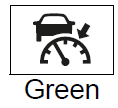 →
→
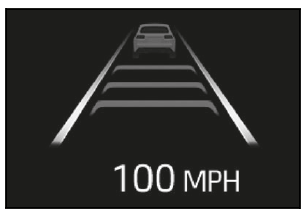 →Vehicle-to-vehicle
distance setting:
Gray.
→Vehicle-to-vehicle
distance setting:
Gray.
Set vehicle speed: White.
Preceding vehicle: Gray → Vehicle in controlled stop
 RSA (Road Sign Assist)
RSA (Road Sign Assist) Cruise control
Cruise controlAC charging cable
Charging Indicator for the Toyota bZ4X
The Toyota bZ4X features a charging indicator that provides real-time updates on the battery's charging status through various illumination patterns. These visual signals help users monitor the progress and ensure efficient power transfer.
How the Cha ...
Toyota bZ4X Rear Camera Detection (RCD) for Pedestrian Safety
When your 2025 Toyota bZ4X is in reverse gear, the Rear Camera Detection (RCD) function is designed to detect pedestrians who are in the area directly behind the vehicle. This system acts as an extra layer of awareness to help you maneuver safely.
If the RCD system detects a pedestrian in the desig ...